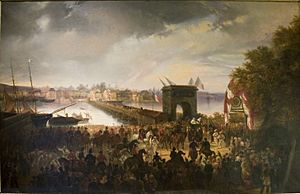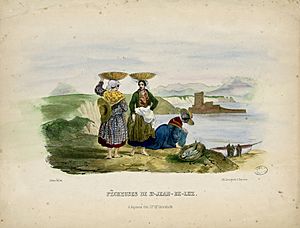Hélène Feillet facts for kids
Hélène Feillet (born November 2, 1812 – died December 9, 1889) was a talented French artist. She was a painter and a lithographer. A lithographer is someone who makes prints using a special stone or metal plate. Hélène was well-known for her small pictures, called vignettes. These pictures were used in books about Bayonne and the Basque Country. She also painted many beautiful portraits of people and landscapes. Her work was shown in the famous Paris art show, called the Salon, starting in 1836.
Contents
Early Life and Art Training
Hélène Feillet was born in Paris, France, on November 2, 1812. Her full name was Joséphine Jeanne Hélène Feillet. Her father, Pierre Jacques Feillet, was also a painter and lithographer. He was her first art teacher.
Later, Hélène studied how to paint portraits with a Dutch artist named Ary Scheffer. Hélène's older sister, Blanche Hennebutte-Feillet, also became a lithographer. Art was a big part of their family life.
Creating Art in Spain and France
In 1829, Hélène visited Madrid, Spain, with her father and sister. While there, she created lithographs for Spanish magazines. She continued this work even after her family moved to Bayonne, France, in 1834.
Hélène made five special prints for a magazine called El Artista. Two of these prints illustrated poems by José de Espronceda. The other three were for poems by Eugenio de Ochoa. These prints are seen as some of the best romantic illustrations from that time.
Illustrating Books and Tourist Guides
From 1835 to 1840, Hélène Feillet created six lithographs. These were used to illustrate a book by Félix Morel called Bayonne, vues historiques et descriptives. This book showed historical views and descriptions of Bayonne.
Later, Hélène worked with her sister Blanche. They made many illustrations for their brother-in-law, Charles-Henri Hennebutte. These pictures appeared in his travel books for tourists. Some of these books were Album des deux frontières and Guide du voyageur de Bayonne à Saint-Sébastien.
Paintings and Exhibitions
Even though she made many lithographs, Hélène Feillet was mostly a painter. She showed her paintings at the Paris Salon starting in 1836. The Salon was a very important art exhibition in France.
Some of her famous paintings include a portrait of Juana Cano from 1836. She also painted "View of the surroundings of Bayonne, taken at Boucau" in 1839. Other notable works are "Spanish woman at church" and "Gypsy woman in San Isidro, near Madrid". Her painting "Arrival in Bayonne of the Duke and Duchess of Orléans" was painted between 1839 and 1840. It was shown at the Salon in 1842.
Later Life and Legacy
Hélène Feillet also received special requests to paint. She created artworks to decorate the chapel of the Military Hospital in Bayonne. She also painted for the church at Jasse in Béarn.
The money she earned from her art allowed her to build a large house. This house had a beautiful view of the beach in Biarritz. She was also able to buy a property called Daguerre in Brindos. She lived there with her father. Hélène Feillet passed away in Biarritz on December 9, 1889.
See also
 In Spanish: Hélène Feillet para niños
In Spanish: Hélène Feillet para niños




